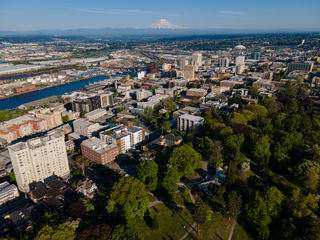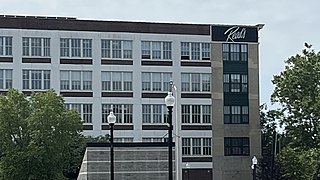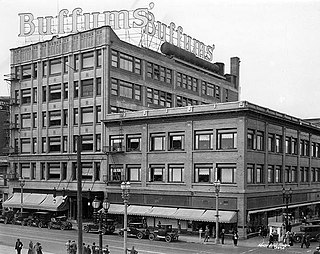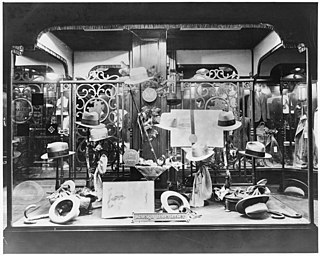
Saks Fifth Avenue is an American luxury department store chain headquartered in New York City and founded by Andrew Saks. The original store opened in the F Street shopping district of Washington, D.C. in 1867. Saks expanded into Manhattan with its Herald Square store in 1902 and flagship store on Fifth Avenue in 1924. The chain was acquired by Tennessee-based Proffitt's, Inc. in 1998, and Saks, Inc. was acquired by the Canadian-based Hudson's Bay Company (HBC) in 2013.

Tacoma is the county seat of Pierce County, Washington, United States. A port city, it is situated along Washington's Puget Sound, 32 miles (51 km) southwest of Seattle, 36 miles (58 km) southwest of Bellevue, 31 miles (50 km) northeast of the state capital, Olympia, 58 miles (93 km) northwest of Mount Rainier National Park, and 80 miles (130 km) east of Olympic National Park. The city's population was 219,346 at the time of the 2020 census. Tacoma is the second-largest city in the Puget Sound area and the third-most populous in the state. Tacoma also serves as the center of business activity for the South Sound region, which has a population of about 1 million.

Nordstrom, Inc. is an American luxury department store chain headquartered in Seattle, Washington, and founded by John W. Nordstrom and Carl F. Wallin in 1901. The original Wallin & Nordstrom store operated exclusively as a shoe store, and a second Nordstrom's shoe store opened in 1923. The growing Nordstrom Best chain began selling clothing in 1963, and became the Nordstrom full-line retailer that presently exists by 1971. The company founded its off-price Nordstrom Rack division in 1973, and grew both full-line and off-price divisions throughout the United States in the following years. The full-line division competes with department stores including Bloomingdale's, Macy's, Neiman Marcus, and Saks Fifth Avenue, while the off-price division competes with retailers including the TJX Companies and Ross Stores. Previous expansions beyond the contiguous United States include Puerto Rico (2015–2020) and Canada (2014–2023).

Gimbel Brothers was an American department store corporation that operated for over a century, from 1842 until 1987. Gimbel patriarch Adam Gimbel opened his first store in Vincennes, Indiana, in 1842. In 1887, the company moved its operations to the Gimbel Brothers Department Store in Milwaukee, Wisconsin. It became a chain when it opened a second, larger store in Philadelphia, Pennsylvania, in 1894, moving its headquarters there. At the urging of future company president Bernard Gimbel, grandson of the founder, the company expanded to New York City in 1910.
Fred Meyer is an American chain of supercenter superstores founded in 1922 in Portland, Oregon, United States, by Fred G. Meyer. The stores are found in the northwest U.S., within the states of Oregon, Washington, Idaho, and Alaska. The company was acquired by Kroger in 1998, though the stores are still branded Fred Meyer. The chain was one of the first in the United States to promote one-stop shopping, eventually combining a complete grocery supermarket with a drugstore, bank, clothing, jewelry, home decor, home improvement, garden, electronics, restaurant, shoes, sporting goods, and toys. The Fred Meyer division is headquartered in Portland.
Ohrbach's was a moderate-priced department store with a merchandising focus primarily on clothing and accessories. From its modest start in 1923 until the chain's demise in 1987, Ohrbach's expanded dramatically after World War II, and opened numerous branch locations in the New York and Los Angeles metropolitan areas. Its original flagship store was located on Union Square in New York City. It maintained administrative offices in Newark and in Los Angeles. The retailer closed the Newark offices in the 1970s. Paul László designed the Union Square store as well as many of their other stores.

The Bon Marché, whose French name translates to "the good market" or "the good deal", was a department store chain launched in Seattle, Washington, United States, in 1890 by Josephine and Edward Nordhoff. The name was influenced by Le Bon Marché, the noted Parisian retailer.

White Front was a chain of discount department stores in California and the western United States from 1959 through the mid-1970s. The stores were noted for the architecture of their store fronts which was an enormous, sweeping archway with the store name spelled in individual letters fanned across the top.
The William H. Block Company was a department store chain in Indianapolis and other cities in Indiana. It was founded in 1874 by Herman Wilhelm Bloch, an immigrant from Austria-Hungary who had Americanized his name to William H. Block. The main store was located at 9 East Washington Street in Indianapolis in 1896. The company also identified itself as The Wm. H. Block Co., and Block's.
Lamonts was a chain of department stores founded in Seattle, Washington. The chain was started in 1970 when Pay 'n Save renamed its suburban branches of Rhodes, a department store chain the company acquired in 1965. Lamonts remained a division of Pay 'n Save until 1985. During the 1990s, the chain filed for bankruptcy twice and closed several stores before being sold to Gottschalks in 2000. Gottschalks itself went into bankruptcy and liquidated in 2009.

Read's Department Stores was a Bridgeport, Connecticut-based retail chain founded in 1857 by D. M. Read. Known for its classy, upscale merchandise, the flagship store was once hailed as New England's largest department store. It expanded to several other locations in the 1950s and 1960s, but these closed progressively through the 1980s and 1990s.

Peoples, originally known as The Peoples Store Co., is a defunct chain of department stores once located in the southern and western Puget Sound area of Washington. Founded in 1888 in downtown Tacoma, by 1894 they opened their first branch store in Olympia. In January 1896 they opened their new flagship store at the corner of Pacific and 11th Street in Tacoma, which was the main intersection of downtown at the time. With 5 floors and 50 departments, it was claimed to be the largest and finest department store in the Pacific Northwest at the time. That store would later be expanded to the south in 1957.
Rhodes Brothers was a department store located in Tacoma, Washington, originally established in 1892 as a coffee shop in downtown Tacoma by Albert, William, Henry and Charles Rhodes. In 1903, the brothers would shift into the department store business, opening in the newly built Snell Building at Broadway and 11th Street in the heart of Tacoma's retail core. The store achieved great success, and by 1911, three floors were added to the building, eventually bringing it to 170,000 ft² (15793.52m²), including a tea room and a branch of the Tacoma Public Library. By 1920, even more room was needed and several buildings across the alley were purchased and connected to the main store by a sky bridge. Further additions included a discount annex in 1935, a new men's shop in 1937 and a special vault that could hold 5,000 coats. In 1957, the company opened its first suburban location at the Villa Plaza Shopping Center in Lakewood, Washington. Rhodes also operated a department store in University Village in Seattle in the 1960s. At one time there were signs on highways in Washington that said, "All roads lead to Rhodes," giving the number of miles to the Rhodes store in Tacoma.
The H. & S. Pogue Company was a Cincinnati, Ohio based department store chain founded by two brothers, Henry and Samuel Pogue. They came from County Cavan, Northern Ireland, to Cincinnati and worked in their uncle's dry goods store. They later were able to buy him out and H. & S. Pogue Dry Goods Company was established in 1863 at 111 West Fifth Street. Brothers Thomas, Joseph, and William Pogue would eventually join the enterprise.

Valu-Mart was a chain of discount stores founded in Seattle in 1958. Its parent company was Weisfield's Jewelers. For many years Weisfield's was a store that carried jewelry, as well as televisions, radios, stereos, and other consumer electronics products. Once Valu-Mart was put into place, Weisfield's strictly became a jewelry store. The chain also had stores in Oregon, where they originally were named Villa-Mart. Separate grocery sections in the stores featured curbside grocery pickup by placing the grocery bags into numbered bins that rolled onto a conveyor allowing the customer to drive up to the front of the store to pick them up by giving the attendant a plastic card with the numbered bin they used. The groceries were then loaded into the car usually by store employees.

Buffums, originally written as Buffums' with an apostrophe, was a chain of upscale department stores, headquartered in Long Beach, California. The Buffums chain began in 1904, when two brothers from Illinois, Charles A. and Edwin E. Buffum, together with other partners, bought the Schilling Bros., the largest dry goods store in Long Beach, and renamed it The Mercantile Co. The store grew to a large downtown department store, and starting in the 1950s, grew slowly over the years to be a small regional chain of 16 speciality department stores across Southern California at the time of its closure in 1990.
The Tacoma Mall is the largest shopping center in Tacoma, Washington, United States, and is owned and operated by the Simon Property Group. Anchor tenants include Dick's Sporting Goods, JCPenney, Macy's, and Nordstrom, with one vacant anchor last occupied by Sears, which opened in 1981. The mall opened on October 13, 1965.

Raleigh Haberdasher, more commonly called Raleigh's, was a high end, local men's and women's furnishings store based in Washington, D.C.

Bond Clothing Stores, Bond Clothes, Bond Clothiers, or Bond Stores, was a men's clothing manufacturing company and retailer. The company catered to the middle-class consumer.










